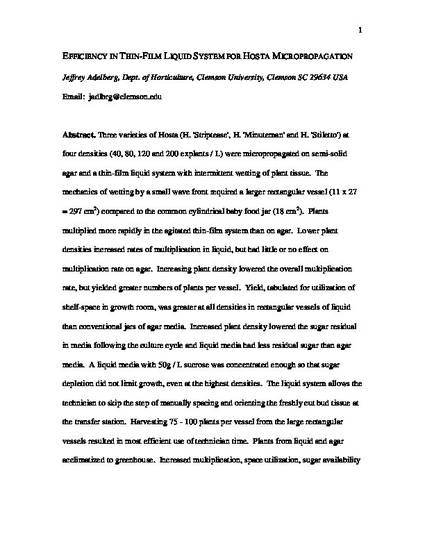
Three varieties of Hosta (‘Striptease’, ‘Minuteman’ and ‘Stiletto’) at four densities (40, 80, 120 and 200 explants per litre) were micropropagated on semi-solid agar and a thin-film liquid system with intermittent wetting of plant tissue. The mechanics of wetting by a small wave front required a larger rectangular vessel (11 × 27=297 cm 2) compared to the common cylindrical baby food jar (18 cm 2). Plants multiplied more rapidly in the agitated thin-film system than on agar. Lower plant densities increased rates of multiplication in liquid, but had little or no effect on multiplication rate on agar. Increasing plant density lowered the overall multiplication rate, but yielded greater numbers of plants per vessel. Yield, tabulated for utilization of shelf-space in growth room, was greater at all densities in rectangular vessels of liquid than conventional jars of agar media. Increased plant density lowered the sugar residual in media following the culture cycle and liquid media had less residual sugar than agar media. A liquid medium with 50 g l−1 sucrose was concentrated enough so that sugar depletion did not limit growth, even at the highest densities. The liquid system allows the technician to skip the step of manually spacing and orienting the freshly cut bud tissue at the transfer station. Harvesting 75–100 plants per vessel from the large rectangular vessels resulted in most efficient use of technician time. Plants from liquid and agar acclimatized to greenhouse. Increased multiplication, space utilization, sugar availability and worker efficiency was demonstrated to be greater in thin-film liquid than more conventional agar-based system.

This manuscript has been published in the journal Plant Cell, Tissue and Organ Culture. Please find the published version here (note that a subscription may be needed to access this version): link.springer.com